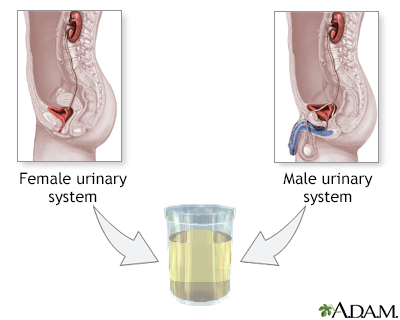Urine 24-hour volume
Urine volume; 24-hour urine collection; Urine protein - 24 hour
The urine 24-hour volume test measures the amount of urine produced in a day. The amounts of creatinine, protein, and other chemicals released into the urine during this period are usually tested as well.
Images



How the Test is Performed
For this test, you must urinate into a special bag or container every time you use the toilet for a 24-hour period.
- On day 1, urinate into the toilet when you get up in the morning.
- Afterward, collect all urine in a special container for the next 24 hours.
- On day 2, urinate into the container when you get up in the morning.
- Cap the container. Keep it in the refrigerator or a cool place during the collection period.
- Label the container with your name, the date, the time of completion, and return it as instructed.
For an infant:
Thoroughly wash the area around the urethra (the hole where urine flows out). Open a urine collection bag (a plastic bag with an adhesive paper on one end).
- For males, place the entire penis in the bag and attach the adhesive to the skin.
- For females, place the bag over the two folds of skin on either side of the vagina (labia). Put a diaper on the baby (over the bag).
Check the infant often, and change the bag after the infant has urinated. Empty the urine from the bag into the container provided by your health care provider.
An active infant can cause the bag to move. It may take more than one try to collect the sample.
When finished, label the container and return it as instructed.
How to Prepare for the Test
Certain drugs can also affect the test results. Your provider may tell you to stop taking certain medicines before the test. Never stop taking medicine without first talking to your provider.
The following may also affect test results:
- Dehydration
- Dye (contrast media) if you have a radiology scan within 3 days before the urine test
- Emotional stress
- Fluid from the vagina that gets into the urine
- Strenuous exercise
- Urinary tract infection
How the Test will Feel
The test involves only normal urination and there is no discomfort.
Why the Test is Performed
You may have this test if there are signs of damage to your kidney function on blood, urine, or imaging tests.
Urine volume is normally measured as part of a test that measures the amount of a substances passed in your urine in a day, such as:
This test may also be done if you have polyuria (abnormally large volumes of urine), such as is seen in people with diabetes insipidus.
Normal Results
The normal range for 24-hour urine volume is 800 to 2,000 milliliters per day (with a normal fluid intake of about 2 liters per day).
The examples above are common measurements for results of these tests. Normal value ranges may vary slightly among different laboratories. Some labs use different measurements or test different samples. Talk to your provider about the meaning of your specific test results.
What Abnormal Results Mean
Disorders that cause reduced urine volume include dehydration, not enough fluid intake, or some types of chronic kidney disease.
Some of the conditions that cause increased urine volume include:
- Diabetes insipidus - renal (abnormality in the kidney's ability to concentrate the urine)
- Diabetes insipidus - central (abnormality in the hormone level that regulates urine concentration)
- Diabetes (also known as diabetes mellitus)
- High fluid intake
- Some forms of kidney disease
- Use of diuretic medicines
Related Information
Creatinine clearance testDiabetes insipidus
Sodium urine test
Potassium urine test
Urea nitrogen urine test
Urine output - decreased
Urination - excessive amount
Nephrogenic diabetes insipidus
Diabetes
Acute kidney failure
End-stage kidney disease
References
Gharavi AG, Landry DW. Approach to the patient with renal disease. In: Goldman L, Cooney KA, eds. Goldman-Cecil Medicine. 27th ed. Philadelphia, PA: Elsevier; 2024:chap 100.
Verbalis JG. Disorders of water balance. In: Yu ASL, Chertow GM, Luyckx VA, Marsden PA, Skorecki K, Taal MW, eds. Brenner and Rector's The Kidney. 11th ed. Philadelphia, PA: Elsevier; 2020:chap 15.
BACK TO TOPReview Date: 8/20/2023
Reviewed By: Jacob Berman, MD, MPH, Clinical Assistant Professor of Medicine, Division of General Internal Medicine, University of Washington School of Medicine, Seattle, WA. Also reviewed by David C. Dugdale, MD, Medical Director, Brenda Conaway, Editorial Director, and the A.D.A.M. Editorial team.

Health Content Provider
06/01/2025
|
A.D.A.M., Inc. is accredited by URAC, for Health Content Provider (www.urac.org). URAC's accreditation program is an independent audit to verify that A.D.A.M. follows rigorous standards of quality and accountability. A.D.A.M. is among the first to achieve this important distinction for online health information and services. Learn more about A.D.A.M.'s editorial policy, editorial process and privacy policy. A.D.A.M. is also a founding member of Hi-Ethics. This site complied with the HONcode standard for trustworthy health information from 1995 to 2022, after which HON (Health On the Net, a not-for-profit organization that promoted transparent and reliable health information online) was discontinued. |
The information provided herein should not be used during any medical emergency or for the diagnosis or treatment of any medical condition. A licensed medical professional should be consulted for diagnosis and treatment of any and all medical conditions. Links to other sites are provided for information only -- they do not constitute endorsements of those other sites. © 1997- 2025 A.D.A.M., a business unit of Ebix, Inc. Any duplication or distribution of the information contained herein is strictly prohibited.
